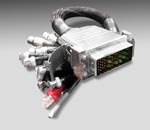Ask any of your colleagues on the consumer systems design/installation side of the fence about HDMI, and depending on their mood, you are likely to get a reaction that runs anywhere from a shrug accompanied by "Yeah, what about it? What's the big deal?" to a more vociferous "It makes me crazy!" Either way, or anywhere in between, the title of this month's column really summarizes the reaction of many, though in many cases it gets a bad rap, with HDMI being blamed for things that are simply not its fault.
Perhaps we should have borrowed yet another cliché, used by some to describe their significant others, or, as the joke would have it, a line used by manufacturers and dealers on occasion to (again, correctly or not) describe their reps: "Can't live with them, can't live without them!" Yes, indeed, that does sort of sum up the feelings of many about HDMI, and you may be able to dismiss it now as something limited to the consumer world, but you can expect to see it on the commercial/industrial side of the fence with increasing frequency as time moves forward.
Bandwidth Blues?
Hmm, increasing frequency. Yet another good pun to use as a lead in! The increased bandwidth of HDMI in its latest 1.3 incarnation is one of the many reasons why you'll see more of it not only in source playback devices, but in audio processors and displays, or "sink devices" in HDMI-speak, as well. After all, HDMI 1.3's capability to carry up to 340 MHz, translating to roughly 10.2 Gbps, along with HDCP content protection, lip-sync correction capability, color depth up to 16 bits per channel, and use of the xvYCC color space make it as compelling in the systems world as for consumer products. Think of this as a way to ultimately do almost anything you could do with a dual-link DVI connection in terms of bandwidth, along with all the other goodies just mentioned.
All well and good at first glance, particularly if you are involved in jobs that require the handling of off-air, cable, or satellite HDTV sources, or either of the blue-laser disc formats, as HDMI is more or less a must in any of those products and the consumer-market derived displays that you will likely use to display the signals. Where HDMI and HDCP products were once the source of questions and quirky behavior, the increased compliance testing required by the latest 1.3a spec, combined with more experience with the underlying technology on the part of the equipment manufacturers, has eliminated many of the early problems that gave HDMI a frequently undeserved bad reputation among installers.
The problems now are more on the physical installation and connection side, that is, your bread and butter. After all, you're probably not doing a home theater where things tend to be in the same room, or at least reasonably close to one another. You need to not only send signals over long run distances, but you frequently need to do so in places where building and electrical codes wouldn't allow the use of non-CL rated consumer interconnects even if they could run the long distance. (See sidebar for some installation tips.)
The Convert
Fortunately, there are a growing number of products that convert the signals normally carried by a standard HDMI interconnect so that they may be sent from place to place via UTP Cat-5 cable or fiber optic links. As with anything HDMI, remember that the higher the resolution, the faster the speed required, and consequently there is a greater demand on bandwidth. In addition, you need to verify that any products you specify are HDCP compliant, otherwise the ability to carry the signal will cease to be important when the system goes dark because something in the converter box inhibits or interrupts HDCP handshaking.
There is no hard and fast rule that dictates a choice of fiber or UTP, as there is the usual stew of variables with run length, resolution, vendor preferences, and of course, budget figuring in the mix. Add in the fact that while UTP may be less expensive, some of the extender systems require dual Cat-5 cables. In general, fiber is likely to be preferred for ultra-long runs, but as they say in other types of ads, "your mileage may vary." However, products are out there that will let you take HDMI to over 100 meters and beyond.
The bottom line? HDMI is going to increasingly become a key aspect of commercial installations, particularly as the HDMI supporters extend their reach into areas other than the current consumer products where they it is the dominant digital audio/video connection. Moving into next year you will see HDMI in data monitor connections, perhaps in a battle with DisplayPort, and you will also see it appear in not just source products such as DVD players and terrestrial, satellite and cable set-tops, but also in acquisition products such as digital still cameras and HDTV camcorders, and even in cell phones with their ubiquitous on-board cameras. That will open up requirements to accommodate HDMI in a wider variety of switching, processing, and distribution systems. At least for now we've hopefully helped you get things connected. We'll return to the rest of the HDMI story a bit further down the road.
Cable & Wire Products 2007
- Wireworks' AV2000-HDSDI MultiMedia Cabling is an upgraded cabling system that is now HD compatible, a vital component for full-system integration. Ideal for multi-media presentation rooms, corporate board rooms, classrooms, and other integrated communications applications, the AV2000 MultiMedia Cabling connects multi-media systems through one simple plug-in, offering contractors a practical solution. AV2000-HDSDI reduces plugging time by up to 95 percent and saves panel space needed for highly integrated systems, by offering a simple solution to the clutter and confusion associated with multiple connector panels.
Intelix DIGI-HDMI-F
The Intelix DIGI-HDMI-F is an HDMI balun capable of distributing a high-definition HDMI signal up to 150 feet over two inexpensive twisted pair cables. The Intelix DIGI-HDMI-F supports 480i, 480p, 720p, and 1080i high-definition video up to 150 feet when using standard Cat-5e cabling, and 1080p high-definition video up to 150 feet when using standard Cat-6 cabling. The Intelix DIGI-HDMI-F balun supports standard HDTV resolutions and is HDCP compliant. Each DIGI-HDMI-F includes the send unit, receive unit, and power supply. The system is powered on the destination end.
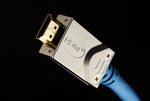
Gefen Simplay HD Cables
Gefen is offering its 6-, 10-, and 15-foot HDMI cables as Simplay HD-certified. These high-end cables ensure a seamless connection between various HDTV sources, including AV receivers, DVD players and set-top boxes, and HDMI displays or projectors. Gefen's high-bandwidth HDMI cables support high definition resolutions from 480i to 1080p and deliver uncompressed video with multi-channel digital audio on the receiving end and full HDCP-compliance unaffected throughout the transmission.
Neutrik OpticalCon
Neutrik's IP65-rated OpticalCon is a solid fiber optic connector system that has now been upgraded for dust-tight and water jet protection, extending its outdoor capabilities. This is especially useful when weatherproof extensions are required. To achieve a water-resistant IP65 connection, additional seals and gaskets have been employed on the chassis connector and cable ends. For earlier versions of OpticalCon cable connection systems, an upgrade kit will be offered so it can be combined with the upgraded NO2-4FDW chassis connector or NAO2-4S75W coupler. The new cable ends are backwards compatible and work with all existing chassis installations.

Clark Wire & Cable CAT5-FLEX
Clark Wire & Cable's CAT5-FLEX brand of cables were designed to exceed EIA/TIA electrical specifications with the added benefits of an extremely durable, ultra-flexible jacket. CAT5-FLEX far exceeds the electrical requirement as defined by TIA/EIA 568-B for Cat-5e cords. This assures reliable 10Base-T or 100Base-T ethernet transmission for plug-to-plug channels up to 70 meters. The polyurethane cable jacket is pressure extruded over the 4-pair core, binding it in place and providing electrical stability during harsh usage. Because of this, CAT5-FLEX cords will withstand mechanical abuse such as vibration, crushing, and impact.
Liberty Wire & Cable DigitaLinx HDMI Fiber Optic Cable
Liberty's new HDMI Fiber Optic Cable is designed to let digital displays, including plasma TVs, digital projectors, LCD monitors, and HDTVs, extend up to 330 feet away from their digital video and audio source. Liberty's patented optical conversion technology enables noise-free, wide-angle XGA high-resolution viewing at the extended distance.
Pragmatic CATS VGA
Pragmatic Communication Systems has developed the CATS VGA high definition video transmission on Cat-5 wires. VGA is the newest advancement in Pragmatic's CATS high performance systems for the distribution of broadcast quality video signals on Cat-5. The system allows for long distances to be traveled without significant loss to signal quality. CATS VGA can run distances of 1000 feet on a single Cat-5 wire. Its transmitter and receiver are CE compliant and powered by 7.5 or 9 V DC.
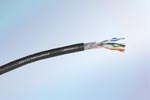
Gepco LSK04HD
Gepco International's LSK04HD heavy-duty, ultra-low skew UTP cable is designed for the transmission of component analog video in a twisted-pair format without hardware delay compensation, all within a heavy-duty construction. Based on the LSK04, each pair in the LSK04HD is constructed from 23-gage solid copper and a precision 100-Ohm dielectric. For added strength and diameter, the LSK04HD has a unique double-jacket design. The inner jacket maintains the critical spacing of the twisted-pair elements, while the outer TPE jacket offers additional strength, durability, diameter, and abrasion resistance.
VizionWare Hi-Wirez Digital Interconnects
The active digital interconnect is a product delivering a wide range of reach independent video resolutions from 480i to 1080p and beyond. VizionWare's Hi-Wirez HDMI cable utilizes patent pending embedded custom chip technology that provides stunning audio and video signal fidelity. The benefits to the installers are interconnects that are higher performance over longer distances and easier to install. They boost higher, noise-susceptible frequencies minimizing signal loss, maintaining proper signaling levels, and allowing for longer and lighter-weight cables.
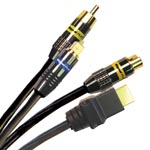
Coleman Cable Signal Plus Series HDMI Cables
Coleman Cable introduced the Signal Plus series of HDMI cables. Signal Plus HDMI cables support standard, enhanced, or high-definition video with bandwidth to spare. The 24-gauge oxygen free copper conductors and triple shielding ensure low attenuation, maximum signal transfer, and RF rejection for up to 50 feet. Signal Plus HDMI cables are in available in 1-, 2-, 3-, 5-, 10-, and 15-meter lengths with a molded strain relief to provide durability.
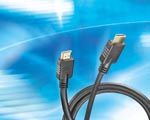
Belden HDMI Shielded Twisted Pair Cables
Belden's HDMI cables are designed to enhance the home theater experience. The new HDMI shielded twisted pair cables provide reliable interface between any compatible digital audio/video source and a compatible digital audio and/or video monitor in the home theater set-up, as well as providing support for standard, enhanced, or high-definition video and multi-channel digital audio, all on a single assembly. All Belden HDMI cables are 1080p verified.
Accell UltraRun Cables
Accell's longest HDMI 1.3 Category 2 cables have lengths up to 131 feet. Accell's UltraRun HDMI 1.3a Category 2 cables ensure peak performance in the today and in the future. The UltraRun cables are CL3 rated for in-wall installation and perfect for use with projectors or wall mounted HDTV's. Accell's UltraRun HDMI 1.3 cables support the HDMI 1.3a Category 2 specification. HDMI Category 2, also known as HDMI 1.3 high-speed, is a quantum leap over HDMI 1.3a Category 1 and earlier HDMI specifications.

Windy City Wire SmartWire
Windy City Wire's SmartWire 4 Element access control cable ensure the neatest of installations. This device color-coded specific composite cable contains the elements needed for most standard access control installations. Element one is a 22/3 pair shielded yellow striped Reader Cable, element 2 is an 18/4 purple stripe for Lock Power, element 3 is a 22/2 green stripe for Contact and element 4 is a 22/4 red stripe is REX/Spare Cable. This cable allows one pull instead of four.
